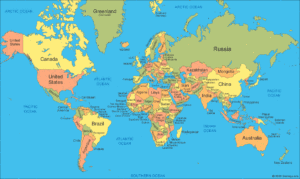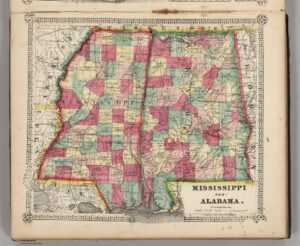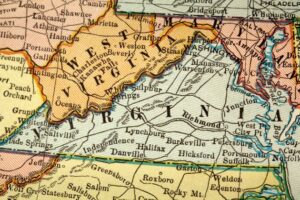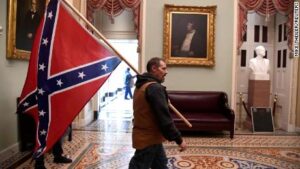 I like living in the United States. Sure, I’ve never lived anywhere else, but I think we have a pretty good quality of life here. We have freedom, and opportunity, and at least in general, civic pride. True, the United States is not perfect. Our healthcare system is among the worst in the free world (It’s the most expensive with some of the worst outcomes), we imprison a higher percentage of our population than any other country on earth, and we don’t do a particularly good job of taking care of the least among us. Even so, most people in the United States enjoy a high standard of living when compared to other countries.
I like living in the United States. Sure, I’ve never lived anywhere else, but I think we have a pretty good quality of life here. We have freedom, and opportunity, and at least in general, civic pride. True, the United States is not perfect. Our healthcare system is among the worst in the free world (It’s the most expensive with some of the worst outcomes), we imprison a higher percentage of our population than any other country on earth, and we don’t do a particularly good job of taking care of the least among us. Even so, most people in the United States enjoy a high standard of living when compared to other countries.
Or so I thought…
I recently went down a rabbit hole trying to determine the best country in which to live. I, like a lot of Americans, take it for granted that the United States is the best place to live. But in recent years, I’ve started seeing more and more evidence that things in the United States are not as good as I’ve previously believed.
Before I get into the meat of this essay, let me state for the record that I still like living in the United States. This is where I was born, where my friends and family live. At least in theory, I can live anywhere I want, and I choose to stay in the United States. My purpose in writing this essay is not to besmirch the United States. But I do think it is valuable to see where our shortcomings might be so we can address them, making the country even better than it already is.
American Exceptionalism would have us believe that the United States is the greatest country on earth, and questioning that notion not only denies what many Americans believe, but is considered unpatriotic. I’ve traveled the world enough to know that people in almost every country feel that their country is the best. But unlike Americans, they don’t trot out the idea of [Fill in the Country] Exceptionalism to actively promote the concept the way we do in the United States. We use it as a sword and a shield. Most other countries simply hold the idea, if they hold it at all, quietly in their hearts. My hope is that this essay, and the data contained herein, will help dispel the corrosiveness of American Exceptionalism and will show us that, while we are great, we still have some work to do.
Background
In 2009, Mladen Adamovic, a former Google software engineer from Serbia started Numbeo to collect data from around the world to determine worldwide consumer prices, crime rates, quality of life indices, healthcare data, etc. Each year, Numbeo post reports comparing countries based on their collected data.
In 2021, Numbeo published a Quality of Life Index that took purchasing power, safety, healthcare, cost of living, property prices, traffic commute time, pollution, and climate into their equation. Initially, I thought this index would tell me which countries were considered the best, and I was interested to find out where the United States finished. But as I studied the list, I started to think that the methodology used for the list didn’t correspond with what I thought should be included in a ranking of quality of life.
Here are the top 20 countries on the Numbeo Quality of Life Index:
- Switzerland
- Denmark
- Netherlands
- Finland
- Austria
- Australia
- Iceland
- Germany
- New Zealand
- Norway
- Estonia
- Oman
- Sweden
- Slovenia
- United States
- Spain
- Japan
- Portugal
- Lithuania
- Canada
I suspected that many of these countries would make any list of the top quality-of-life countries, but there were a few surprises. Most obviously, Oman seems to be an outlier on the list. Slovenia is another country I didn’t expect to see in the top 20. I was also surprised that countries like the United Kingdom, France, and Italy weren’t in the top 20. I decided to put my own list together.
Methodology
I have no doubt that, based on the data they used, the Numbeo list is accurate. The problem I have with the list is, I don’t think, at least for my purposes, they’re using the correct data. Of course, using different data makes my list different, but not necessary better. I admit that. What I wanted to do is rank countries based on the happiness of its citizens, by the amount of freedom they enjoy, and by the relative cost of living in the country. These were the things I felt were the most important when analyzing a country’s quality of life.
Having said that, I’m not ignoring crime rates, healthcare, pollution, etc. These things are baked into the happiness experienced by its citizens. I suspected that the freer a citizenry is, the happier they will be, but I wasn’t sure. So, I turned to the Human Freedom Index published annually by the Cato Institute, and factored in their data. And to round out the data set, I used Numbeo’s Cost of Living index. Utopia may exist, but if it’s unaffordable, I don’t want it on the list.
Equal weight was given to each of World Happiness Report (from World Population Review) rankings and Human Freedom Index rankings, and the countries that made up the resulting list were then ranked based on cost of living. The top 30 countries on the World Happiness Report and the top 30 on the Human Freedom Index made up the final list of 39 countries. Those countries were then viewed in isolation to determine their relative cost of living ranking.
Here’s what each of the individual indexes has to say about their methodology:
World Happiness Report
Founded in 2011 by Shane Fulmer, World Population Review is a website dedicated to global population data and trends. According to Fulmer, “Most demographic data is hidden in spreadsheets, behind complex APIs, or inside cumbersome tools. World Population Review’s goal is to make this data more accessible through graphs, charts, analysis, and visualizations.” World Population Review monitors world population with real census and UN data, as well as real-time estimates based on birth and death rates.
“The World Happiness Report looks at countries with respect to their performance of six particular variables:
- Gross domestic product per capita
- Social support
- Healthy life expectancy
- Freedom to make your own life choices
- Generosity of the general population
- Perceptions of internal and external corruption levels”
Human Freedom Index
The 2021 Human Freedom Index was authored and compiled by Ian Vasquez and Fred McMahon of the Cato Institute, a Libertarian think tank headquartered in Washington, DC. The following was taken directly from the report.
“The Human Freedom Index (HFI) presents a broad measure of human freedom, understood as the absence of coercive constraint. This sixth annual index uses 76 distinct indicators of personal and economic freedom in the following areas:
- Rule of Law
- Security and Safety
- Movement
- Religion
- Association, Assembly, and Civil Society
- Expression and Information
- Identity and Relationships
- Size of Government
- Legal System and Property Rights
- Access to Sound Money
- Freedom to Trade Internationally
- Regulation of Credit, Labor, and Business
“The HFI is the most comprehensive freedom index so far created for a globally meaningful set of countries representing 94 percent of the world’s population. The HFI covers 162 countries for 2018, the most recent year for which sufficient data are available. The index ranks countries beginning in 2008, the earliest year for which a robust enough index could be produced.
“The findings in the HFI suggest that freedom plays an important role in human well-being, and they offer opportunities for further research into the complex ways in which freedom influences, and can be influenced by, political regimes, economic development, and the whole range of indicators of human well-being.”
Cost of Living Index
The following was taken from the Numbeo website:
“To collect data Numbeo relies on user inputs and manually collected data from authoritative sources (websites of supermarkets, taxi company websites, governmental institutions, newspaper articles, other surveys, etc.). Manually collected data from established sources are entered twice per year.
“We perform automatic and semi-automatic filters to filter out noise data. We utilize user behavior and previous data for the city/country to determine likelihood of a certain input whether it is considered as spam. There are more than 30 sophisticated filters which in use. The performance rate of the filter is enhanced once more inputs are included.
“One of the advanced filters tries to eliminate bad training data. It digs into discarded data (spam data) and if it notices irregularities, it moves them back into the calculation. The algorithm which determines irregular spam data uses the following filter: if for a single item in a city exists a high number of classified spam data with a relatively small standard deviance from users that have more positive inputs, that means these data are misclassified and the algorithm fix it to the proper classification.
“To summarize our filters, Numbeo uses heuristic technology to get the data quality. Using the existing data Numbeo periodically discards data which are most likely incorrect statistically.
“Numbeo also archives the values of old data (our default data deprecation policy is 12 months, although we use data up to 18 months old when we do not have fresh data and indicators are suggesting that inflation is low in a particular country). The values of old data are preserved to be used for historical purposes.
“To aggregate data for a country, we use all entries (for all cities) to calculate average country data. Note that it is different from the aggregating calculated data for all cities in that country. So, in calculations for the country, we are weighting a city by the number of contributors. Since there are higher number of inputs for a country than for a city, aggregate data showed on a country level consists, in general, much more data points.”
Surprises
As I mentioned earlier, I was surprised to see Oman and Slovenia on the ranking of the top 20 countries for quality of life. For instance, Oman ranked 133rd on the Human Freedom Index, and wasn’t listed at all on the World Happiness Report. It’s hard to imagine that the cost of living or level of crime or pollution could make up for the lack of relative freedom or happiness in Oman.
On the other hand, I was wrong about Slovenia, which was formerly a part of Yugoslavia. Slovenia ranks 33rd on the World Happiness Report, as well as 33rd on the Human Freedom index. Both rankings eliminated Slovenia from this list of best countries to live, but it was much closer than I anticipated.
I was also surprised that other countries I expected to make the ranking of best countries to live didn’t make the top 30 on the World Happiness Report or Human Freedom Index. These Countries include Greece (77th on WHR, 56th on HFI), Brazil (32nd on WHR, 88th on HFI), Colombia (44th on WHR, 86th on HFI), Argentina (55th on WHR, 70th on HFI), and South Africa (109th on WHR, 68th on HFI).
And then there’s Panama…
Many years ago, I questioned where I would move if for some reason I had to leave the United States. I considered several places and was influenced heavily by International Living, a publication targeted at American ex-pats and ex-pat wannabes. It was through International Living that I became interested in Panama. They seemed to have everything: a democratically elected government, low cost of living, tropical location, the Panamanian dollar was tied to the American dollar, and there were a lot of English speakers among the country’s population. Panama seemed great. Yet, they were only 36th on the WHR and 40th on the HFI. Sorry, Panama. Close, but no cigars.
A Quick Caveat
You’ll note that Hong Kong made the list of best places to live. They finished 78th on the World Happiness Report, 3rd on the World Freedom Index, and 27th on the Cost of Living Index, placing them 35th on my Best Places to Live List. However, most of the data used for the 2021 editions of the three resource lists are from 2018, the most recent year that complete data is available.
Things have changed for the worse in Hong Kong since 2018. China has clamped down on Hong Kong, limiting citizens’ rights and implementing more restrictive regulations. As a result, Hong Kong most assuredly will not appear as high on future lists.
Also, both the United Arab Emirates and Saudi Arabia made the Best Places to Live List. UAE was 38th and Saudi Arabia 39th. They are on the list because they met the requirement of being in the top 30 on one of the resource lists. In both cases, they were top 30 on the World Happiness Report. However, both countries were ranked so poorly on the Human Freedom Index that I would never seriously consider either country to be one of the best places to live. Their people seem to be pretty happy, but they are both among the least free countries in the world.
The Results
And the best place to live in the whole wide world is:
Canada?
I assumed Canada would be on the list, but I didn’t expect them to take the top spot. Don’t get me wrong, Canada is great. I just didn’t think it was this great.
Canada didn’t lead either the World Happiness Report of the Human Freedom Index, but it did very well in both. They were 11th on the World Happiness Report and 6th on the Human Freedom Index. And among the finalist countries, they were 15th in cost of living. In the end, they were good enough in each category to earn the top spot.
Following close behind were Finland and New Zealand. Finland took the top spot on the World Happiness Report, and New Zealand did the same on the Human Freedom Index. Their results, when coupled with their cost-of-living rankings (22nd and 25th respectively) propelled Finland and New Zealand to a tie for second on the Best Places to Live List.
The Netherlands was alone in fourth position, finishing 6th in the World Happiness Report, and tied with Finland for 11th on the Human Freedom Index.
Tied for 5th on the Best Places to Live List were Denmark and Germany. Although they were tied, they went about it very differently. Denmark did great in both the World Happiness Report and the Human Freedom Index, finishing 2nd in the WHR and 4th on the HFI. Germany was 17th in the World Happiness Report and 9th on the Human Freedom Index. So, how did they tie? It came down to the cost-of-living. Denmark was 24th out of the 39 countries on the list, while Germany was 16th.
Here is the entire Best Places to Live List:
| # |
Country |
Happiness Index |
Freedom Index |
Cost of Living |
Combined Total |
| 1 |
Canada |
11 |
6 |
15 |
32 |
| 2 |
Finland |
1 |
11 |
22 |
34 |
| 2 |
New Zealand |
8 |
1 |
25 |
34 |
| 4 |
Netherlands |
6 |
11 |
24 |
41 |
| 5 |
Denmark |
2 |
4 |
36 |
42 |
| 5 |
Germany |
17 |
9 |
16 |
42 |
| 5 |
Sweden |
7 |
9 |
26 |
42 |
| 8 |
Switzerland |
3 |
2 |
39 |
44 |
| 9 |
Austria |
9 |
15 |
21 |
45 |
| 10 |
Czech Republic |
19 |
24 |
4 |
47 |
| 10 |
United Kingdom |
13 |
17 |
17 |
47 |
| 12 |
Australia |
12 |
5 |
31 |
48 |
| 13 |
Ireland |
16 |
7 |
30 |
53 |
| 13 |
United States |
18 |
17 |
18 |
53 |
| 15 |
Luxembourg |
10 |
11 |
35 |
56 |
| 16 |
Norway |
5 |
15 |
38 |
58 |
| 16 |
Taiwan |
25 |
19 |
14 |
58 |
| 18 |
Iceland |
4 |
20 |
37 |
61 |
| 19 |
Costa Rica |
15 |
42 |
7 |
64 |
| 20 |
Lithuania |
41 |
21 |
3 |
65 |
| 20 |
Malta |
22 |
23 |
20 |
65 |
| 22 |
Belgium |
20 |
25 |
23 |
68 |
| 23 |
Spain |
28 |
29 |
12 |
69 |
| 24 |
Estonia |
51 |
8 |
11 |
70 |
| 25 |
Chile |
39 |
30 |
5 |
71 |
| 26 |
Uruguay |
26 |
38 |
8 |
72 |
| 27 |
Italy |
30 |
31 |
19 |
80 |
| 28 |
France |
23 |
33 |
28 |
84 |
| 29 |
Latvia |
57 |
22 |
9 |
88 |
| 30 |
Singapore |
31 |
28 |
32 |
91 |
| 31 |
Guatemala |
29 |
63 |
2 |
94 |
| 32 |
Portugal |
59 |
26 |
10 |
95 |
| 33 |
Israel |
14 |
53 |
33 |
100 |
| 34 |
Japan |
62 |
11 |
34 |
107 |
| 35 |
Hong Kong |
78 |
3 |
27 |
108 |
| 36 |
Mexico |
24 |
86 |
1 |
111 |
| 37 |
Korean Republic |
61 |
26 |
29 |
116 |
| 38 |
United Arab Emirates |
21 |
124 |
13 |
158 |
| 39 |
Saudi Arabia |
27 |
151 |
6 |
194 |
What We Can Learn From The List
The United States came in a middling 13th place on the Best Places to Live List, tied with Ireland. In fact, the people of Ireland are, on average, happier than Americans, and enjoy more freedom than we do in the United States. The only reason we ended up tied with Ireland was because of the comparatively lower cost-of-living in the United States (18th) when compared to Ireland (30th).
We in the United States have a skewed view of the world. We are confident that one of the things that make us great is our relatively low taxes. Sure, we don’t have some of the nice things other countries have—like universal healthcare and no-cost college—but we have lower tax rates. We get to keep more of the money we earn, and that makes us happy.
Not so fast.
The countries at the top of the World Happiness Report are generally happier than people in the United States. According to Investopedia, the United States ranks 24th in the world for single tax-payer rate, and 25th for married couple rate. Yet, we are only 18th on the World Happiness Report. The vast majority of the countries ahead of us on the WHR have a higher personal income tax rate than we do. Do high taxes lead to happiness? Probably not, but the services those taxes pay for likely do.
Likewise, most of the countries ahead of us on the Human Freedom Index also have higher taxes than the United States. I think a lot of Americans conflate low taxes with high freedom, but it doesn’t seem to work out that way. Many high tax countries seem to enjoy more individual freedom than we do in the United States.
What About Guns?
One freedom that Americans enjoy more than any other country in the world is the freedom to purchase and possess firearms. It is very easy to obtain a permit to carry a firearm in public, and despite a plague of mass shootings, legislators in many states are trying to make it easier, rather than harder, for citizens to carry loaded firearms in public.
Here’s why I bring this up: Not too long ago I was having a conversation with a friend about the whole concept of freedom. COVID-19 and the need to wear a mask in public started the conversation, but it quickly broadened into the larger topic of freedom. I mentioned that New Zealand, along with several other countries, enjoyed more freedom that we do in the United States, yet, in many of those countries, citizens had willingly worn masks. They didn’t complain about having their “freedom” taken away from them, and as a result, their countries and their economies had recovered, while ours continued to suffer.
“Can people in these other countries buy guns with little or no restriction?” he asked.
I admitted that in most other countries, firearms were not nearly as easy to obtain as in the United States.
“Then they’re not really free, are they?”
That stopped me cold. It’s hard to have a conversation with an irrational person. If he equates “easy access to guns” with “freedom,” there’s not much I can tell him that he’s going to listen to and accept. I can’t explain to him how our societal happiness decreases in part because of easy access to guns. I can’t tell him that one of the reasons our overall freedom suffers is because we sacrifice those freedoms in favor of widespread gun availability. He simply would not hear of it. To him, ability to purchase guns equals freedom.
Lest I be misunderstood, I’m not in favor of a ban on gun sales. The 2nd Amendment is one of our country’s most cherished Constitutional rights. Even so, I do think there are common sense steps we can take to make it easier to keep guns out of the hands of those who shouldn’t have them, and I think it’s time we address the gun culture in this country. The power of the gun lobby and the sway it has over our elected officials makes the United States a less good place to live.
Final Thoughts
I have no intention of moving out of the United States. This is my home and I’m not looking to make a change. However, I think we in the United States can learn a lot from other countries, particularly countries that enjoy more happiness and freedom than we do.
Too many people in the United States have been made to believe, through the concept of American Exceptionalism, that the United States is better than any other country. We’re good, but we’re not the freest and we’re not the happiest. In fact, we’re not even in the top 10 in either category. That might surprise a lot of Americans, but until we recognize that we’re not the best, it’s much harder to make the commitment to become better.
The Biden Administration, along with most Democrats in Congress, seem committed to strengthening the social safety net and rebuilding the infrastructure in the United States. There’s also a push for universal healthcare, two-years of no-cost college, and perhaps student loan forgiveness. There has even been talk of universal basic income for adults, free or subsidized childcare, and other programs designed to help low- and middle-income families.
Even if you are opposed to these programs, it is important to recognize that they are similar to programs already in place in several countries that enjoy more happiness and freedom than we do in the United States. If these programs could increase the happiness of most Americans and would provide us with ever greater freedoms, would they be worth the additional taxes required to pay for them? I don’t know the answer, but people in countries with more happiness and more freedom almost universally believe the better lifestyle they enjoy is well worth the cost.

 Here’s the question:
Here’s the question:
 Why do smart people do dumb things? I’m not talking about ticky-tacky little things like backing the car into a garbage can or touching a hot stove. After all, people are human, and humans make mistakes. What I’m talking about is choosing to do the wrong thing even when you know it is wrong.
Why do smart people do dumb things? I’m not talking about ticky-tacky little things like backing the car into a garbage can or touching a hot stove. After all, people are human, and humans make mistakes. What I’m talking about is choosing to do the wrong thing even when you know it is wrong. I have a sinking feeling, a sense of dread that is threatening to consume me. And every day, it seems to get worse.
I have a sinking feeling, a sense of dread that is threatening to consume me. And every day, it seems to get worse. I was watching 60 Minutes recently and saw a story about the Tulsa Massacre of 1921. It was an amazing story, made all the more amazing by the fact that the massacre occurred 100 years ago, yet I had never heard of it. I wasn’t alone. The 60 Minutes crew interviewed a man who was born and educated in Tulsa, but he had never heard of the massacre either.
I was watching 60 Minutes recently and saw a story about the Tulsa Massacre of 1921. It was an amazing story, made all the more amazing by the fact that the massacre occurred 100 years ago, yet I had never heard of it. I wasn’t alone. The 60 Minutes crew interviewed a man who was born and educated in Tulsa, but he had never heard of the massacre either. I like living in the United States. Sure, I’ve never lived anywhere else, but I think we have a pretty good quality of life here. We have freedom, and opportunity, and at least in general, civic pride. True, the United States is not perfect. Our healthcare system is among the worst in the free world (It’s the most expensive with some of the worst outcomes), we imprison a higher percentage of our population than any other country on earth, and we don’t do a particularly good job of taking care of the least among us. Even so, most people in the United States enjoy a high standard of living when compared to other countries.
I like living in the United States. Sure, I’ve never lived anywhere else, but I think we have a pretty good quality of life here. We have freedom, and opportunity, and at least in general, civic pride. True, the United States is not perfect. Our healthcare system is among the worst in the free world (It’s the most expensive with some of the worst outcomes), we imprison a higher percentage of our population than any other country on earth, and we don’t do a particularly good job of taking care of the least among us. Even so, most people in the United States enjoy a high standard of living when compared to other countries. If you look at a map of the United States and focus on the southeast portion of the country, you might notice something kind of unusual. Look directly at Mississippi and Alabama. See anything strange or interesting. If you see that the two states are near mirror images of each other, you’re seeing what I’m seeing. There’s a story behind why these two states look so much alike.
If you look at a map of the United States and focus on the southeast portion of the country, you might notice something kind of unusual. Look directly at Mississippi and Alabama. See anything strange or interesting. If you see that the two states are near mirror images of each other, you’re seeing what I’m seeing. There’s a story behind why these two states look so much alike. People of a certain age don’t even have to think about what words come after the phrase, “Almost Heaven.” The obvious answer is, “West Virginia.” But is that really correct?
People of a certain age don’t even have to think about what words come after the phrase, “Almost Heaven.” The obvious answer is, “West Virginia.” But is that really correct? I met Brett when we were both in fourth grade. He had a curly mop of hair, a crooked smile, and a mischievous personality. He liked to have fun and didn’t take much of anything too seriously. We became fast friends.
I met Brett when we were both in fourth grade. He had a curly mop of hair, a crooked smile, and a mischievous personality. He liked to have fun and didn’t take much of anything too seriously. We became fast friends. In early July 1854, Abraham Lincoln took some time to prepare for his upcoming campaign by writing down some thoughts he could use in speeches on the campaign trail. At the time, Lincoln’s political philosophy of the purpose of government was considered radical in comparison to his contemporaries. No other president before him took such an activist approach to governmental purpose as Lincoln did.
In early July 1854, Abraham Lincoln took some time to prepare for his upcoming campaign by writing down some thoughts he could use in speeches on the campaign trail. At the time, Lincoln’s political philosophy of the purpose of government was considered radical in comparison to his contemporaries. No other president before him took such an activist approach to governmental purpose as Lincoln did. The violent, bloody siege of the Capital on 1/6/21 was the logical conclusion of the big lie Donald Trump has been telling in one form or another since last summer. The big lie, that the election was stolen from him, has been amplified by Republicans and right-wing media incessantly since Trump first broached the subject. The claim was ramped up following the election, and was bolstered first by frivolous lawsuits, then by calls to ignore or replace certified electors from swing states that voted for Biden, and finally by an attempted takeover of our government by extremists who heard the big lie, believed it, then acted on it.
The violent, bloody siege of the Capital on 1/6/21 was the logical conclusion of the big lie Donald Trump has been telling in one form or another since last summer. The big lie, that the election was stolen from him, has been amplified by Republicans and right-wing media incessantly since Trump first broached the subject. The claim was ramped up following the election, and was bolstered first by frivolous lawsuits, then by calls to ignore or replace certified electors from swing states that voted for Biden, and finally by an attempted takeover of our government by extremists who heard the big lie, believed it, then acted on it.